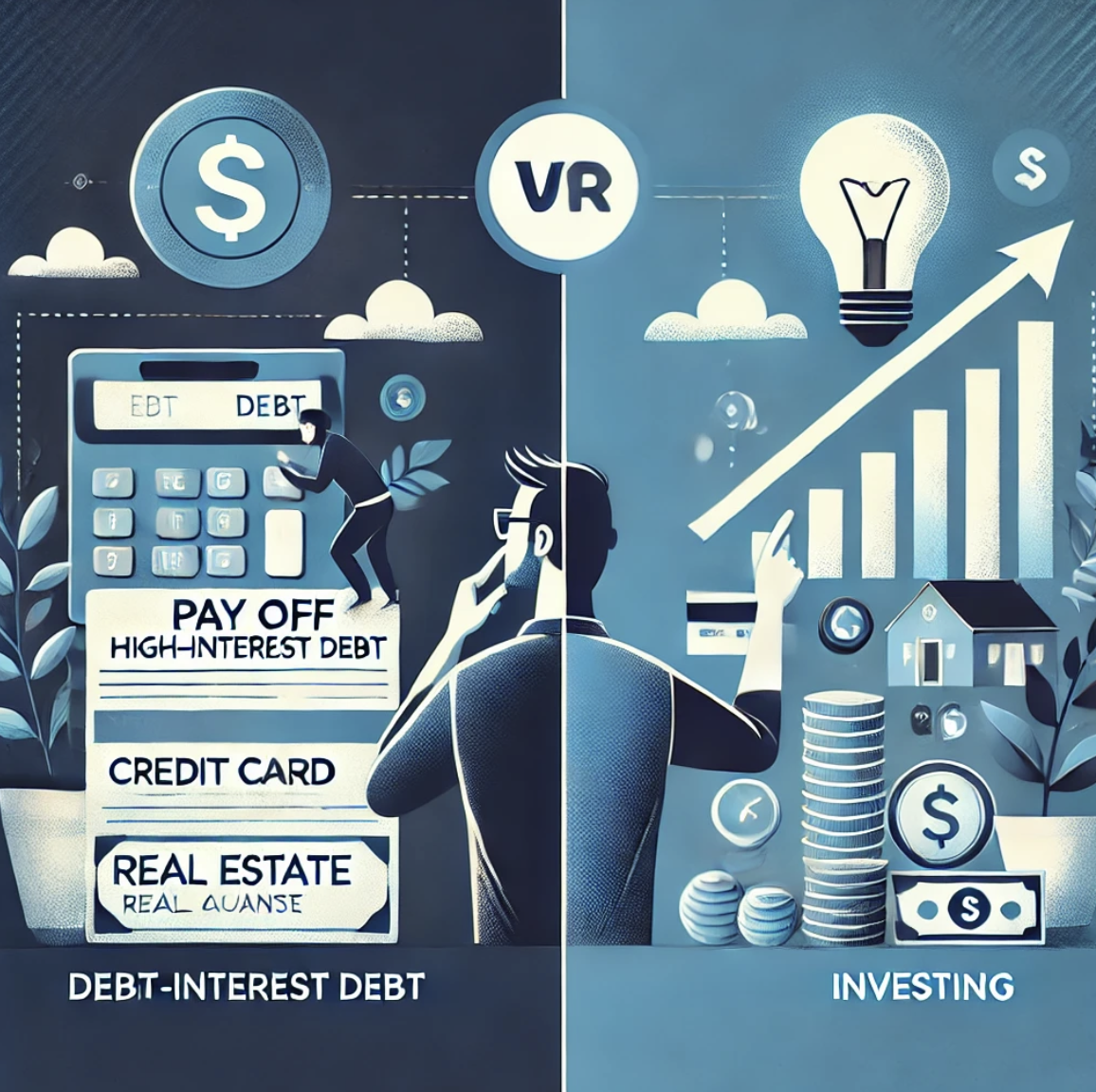
Balancing Debt and Investment Crafting a Strategy
Balancing Debt and Investment: Crafting a Strategy
When it comes to personal finances, the delicate balancing act of managing debt and investing for the future can seem overwhelming. On one hand, you want to build wealth through investments. On the other, you need to address the financial burden of existing debt. The key to achieving both short-term relief and long-term wealth is crafting a strategy that allows for an effective balance between debt repayment and investment.
In this comprehensive guide, we will walk you through a structured strategy for balancing debt and investment. By following a clear set of steps, you can gain financial control, work toward eliminating high-interest debt, and make smart investments for future growth. Let’s dive into the process.
Step 1: Lay Everything Out
Clarity Is Key: Understand Your Full Financial Picture
The first step in any financial strategy is to lay everything out. If you want to craft a solid plan for managing both debt and investments, it’s critical to have a clear and comprehensive understanding of your finances. This begins with assessing all of your outstanding debts and investments.

Listing Debts
Start by listing all your debts. Be sure to include the following details for each debt:
The total amount you owe
The interest rate
The monthly payment
The remaining term of the debt
By organizing this information, you can quickly identify which debts carry the heaviest interest rates and, therefore, are costing you the most. High-interest debts like credit cards can drain your finances, while low-interest debts such as mortgages or student loans might not require as much urgency. Understanding the scale of your obligations is essential to determining where your financial priorities lie.
Evaluating Investment Needs
At the same time, it’s important to take a good look at your investment needs and set clear financial goals. Ask yourself the following questions:
What are your short-term and long-term financial goals?
Are you saving for retirement, a home, or education?
What types of investments align with your goals—stocks, real estate, bonds, etc.?
This step is critical in setting the direction for your investment strategy. Knowing what you want to achieve with your investments will help you prioritize and make informed decisions later on. It’s also an opportunity to assess how much risk you’re willing to take on. If you’re more risk-averse, consider less volatile investments, whereas if you’re comfortable with risk, you might pursue higher-return opportunities.
By laying out all of your debts and investment needs, you’ll gain clarity about where you currently stand financially. This overview will provide a foundation for the next step of crafting a strategy that balances both aspects.
Step 2: Prioritize Debt Repayment vs. Investing
Allocating Money Between Debt and Investments
Now that you have a clear understanding of your debts and investment needs, the next step is to decide how to allocate your money. It’s important to understand that, at times, paying off debt will take priority, especially if the debt carries high interest rates. The ultimate goal is to stop the cycle of accruing interest on your debts, as this can significantly affect your ability to build wealth.

Focus on High-Interest Debts First
High-interest debts should be your primary focus. These are typically credit card balances, payday loans, or personal loans with high-interest rates. The reason these should take precedence is simple: the interest on these debts compounds quickly, making it much harder to get out of debt. For example, if you have a credit card balance with a 20% interest rate, the amount you owe could grow faster than any returns you might make on investments.
One effective strategy is the debt avalanche method—where you put extra money toward the debt with the highest interest rate first, while making minimum payments on your other debts. Once the highest-interest debt is paid off, you can focus on the next one, and so on. This approach minimizes the amount of interest you pay over time.
Handling Low-Interest Debts Flexibly
On the other hand, low-interest debts like student loans or mortgages don’t carry the same urgency. While it’s still important to stay on top of these payments, you may be able to approach them more flexibly. You can continue making the minimum payments while also allocating some funds toward investments. This is especially beneficial if your mortgage has a low interest rate (e.g., 3-4%), as the cost of carrying that debt is relatively low compared to what you could potentially earn by investing.
However, it's important to avoid ignoring low-interest debt entirely. Keeping your obligations up to date ensures that your credit score remains healthy and that you are not adding to your liabilities unnecessarily. In addition, if you find yourself in a position where extra funds are available, paying off some of these low-interest debts ahead of schedule can help you reduce financial stress.
Balancing the Priorities
The balance between paying down high-interest debt and investing depends largely on your personal financial situation and goals. If you have substantial high-interest debt, it may be better to focus on paying it off first before committing significant funds to investments. However, if your debt is manageable and you have access to employer-sponsored retirement plans (e.g., a 401(k) with a match), it may be wise to invest at least enough to take full advantage of the employer contribution, as this represents “free money.”
Step 3: Create a Strategic Mix
Building a Balanced Financial Plan
Striking a balance between debt repayment and investing is essential to building long-term financial stability. Your strategy should reflect both your immediate need for financial relief and your long-term goal of building wealth. This is where the creation of a strategic mix becomes important.
Aggressive Debt Repayment with Long-Term Investing

One of the most effective ways to balance these two priorities is to pay off high-interest debt aggressively, while simultaneously contributing to investments that will grow over time. For example, if you have a manageable mortgage or student loan, consider making extra payments toward your high-interest debts while also investing in tax-advantaged retirement accounts, such as a 401(k) or an IRA.
You can also diversify your investments to balance risk. Contributing to a low-risk, long-term investment vehicle like an IRA or Roth IRA, while investing in stocks or bonds for higher potential returns, allows you to grow wealth in multiple ways. Remember, the goal is to build a diversified portfolio that matches your risk tolerance and investment time horizon.
Real Estate and Other Investment Opportunities
Real estate is another popular option for building wealth over time. If your financial situation allows, consider investing in rental properties or REITs (Real Estate Investment Trusts). Real estate can provide a consistent stream of passive income and potential appreciation over time, adding a tangible element to your investment strategy.
Maintaining Flexibility
It's important to maintain some flexibility in your approach. Life circumstances change, and sometimes you may need to adjust your strategy. The key is to regularly review your finances and adapt accordingly. If you receive a windfall or a raise at work, for example, consider using part of it to pay down high-interest debt, while investing the remainder to further grow your wealth.
Step 4: Take Action and Stay Consistent
The Importance of Consistency
With a clear strategy in place, it’s time to take action. Financial plans are only effective when you put them into practice. Regularly review your debts and investments, and make adjustments when necessary. The key to achieving success is consistency. Keep making regular payments toward your debts and regularly contribute to your investments.
Monitor Your Progress
Your financial situation may evolve over time. As you pay down debt and accumulate wealth, revisit your goals to ensure they are still aligned with your current life circumstances. For example, if you pay off a significant chunk of high-interest debt, you might choose to allocate more toward investments.
Another important factor is the power of compounding. The earlier you begin investing, the more time your money has to grow. Even small contributions to retirement accounts or other investment vehicles can add up over time, helping you build long-term wealth.
Stay Disciplined
While it’s easy to be tempted to make impulsive purchases or forego paying down debt to chase quick investment opportunities, maintaining financial discipline is crucial. The most successful investors and debt managers are those who stay focused on their long-term goals and resist short-term distractions.
Related Videos: Debt Management Playlist
